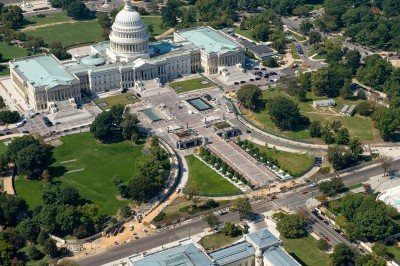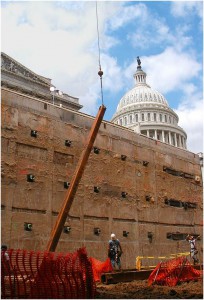U.S. Capitol Visitor Centre
The U.S. Capitol Visitor Center is the newest addition to the United States Capitol. It was designed to make the U.S. Capitol more accessible, convenient, secure, and informative for millions of visitors each year. It is a large underground expansion space for the US Congress of nearly 54,000 square meter on three floors which is approximately three quarters the size of the Capitol itself. The excavation for the Capitol Visitor Center required the removal of 500,000 cubic meter of soil. The entire facility is located underground on the east side of the Capitol so as not to detract from the appearance of the Capitol and the grounds around it.
To protect the capital from damage due to the excavation a retaining wall was built into the ground first prior to excavating for the Visitor Center. The wall lined the footprint of the project and stretched for approximately 800 meters. The wall was a meter thick and approximately 23 meters deep. Nearly 22 tons of rebar was within every five meters of the perimeter slurry wall. The slurry wall was approximately 5 meters deeper than the bottom floor slab of the Visitor Center.
As excavation went down, tie-backs were drilled through the slurry wall to ensure that the pressure of the Capitol building or surrounding terrain did not force the slurry wall itself to collapse. Approximately 150 tie-backs were installed at 5-meter depth increments (a total of 450 tie-backs for the completed structure).
Because the Capitol is built on a hill, groundwater was not a primary concern for this project.
To protect the capital from damage due to the excavation a retaining wall was built into the ground first prior to excavating for the Visitor Center. The wall lined the footprint of the project and stretched for approximately 800 meters. The wall was a meter thick and approximately 23 meters deep. Nearly 22 tons of rebar was within every five meters of the perimeter slurry wall. The slurry wall was approximately 5 meters deeper than the bottom floor slab of the Visitor Center.
As excavation went down, tie-backs were drilled through the slurry wall to ensure that the pressure of the Capitol building or surrounding terrain did not force the slurry wall itself to collapse. Approximately 150 tie-backs were installed at 5-meter depth increments (a total of 450 tie-backs for the completed structure).
Because the Capitol is built on a hill, groundwater was not a primary concern for this project.
Washington, D.C.,
United States

- Underground public service facilities (archives, libraries, swimming pools)
- Recreation facilities
$621 million
Project construction
2002-08-01
2008-11-30
- Architectural quality of urban environment has to be improved
- Service quality of the urban environment has to be improved
- Valuable surface space must be kept available or become available again
• Increase of the capacity of the Capitol
• Preserve accessibility of the Capitol
• Preserve clear view of the Capitol
• Provide welcoming and educational environment for visitors of the Capitol
• Preserve accessibility of the Capitol
• Preserve clear view of the Capitol
• Provide welcoming and educational environment for visitors of the Capitol
- Architectural factors
- Quality of life
Increasing the capacity of the Capitol for visitors without the obstruction of the clear view of the Capitol
The soil make-up of the site was Coarse sand and gravel in the upper layers with P3 clay, or Potomac clay below. The Potomac clay was a fairly dense material that did not allow water permeation.


